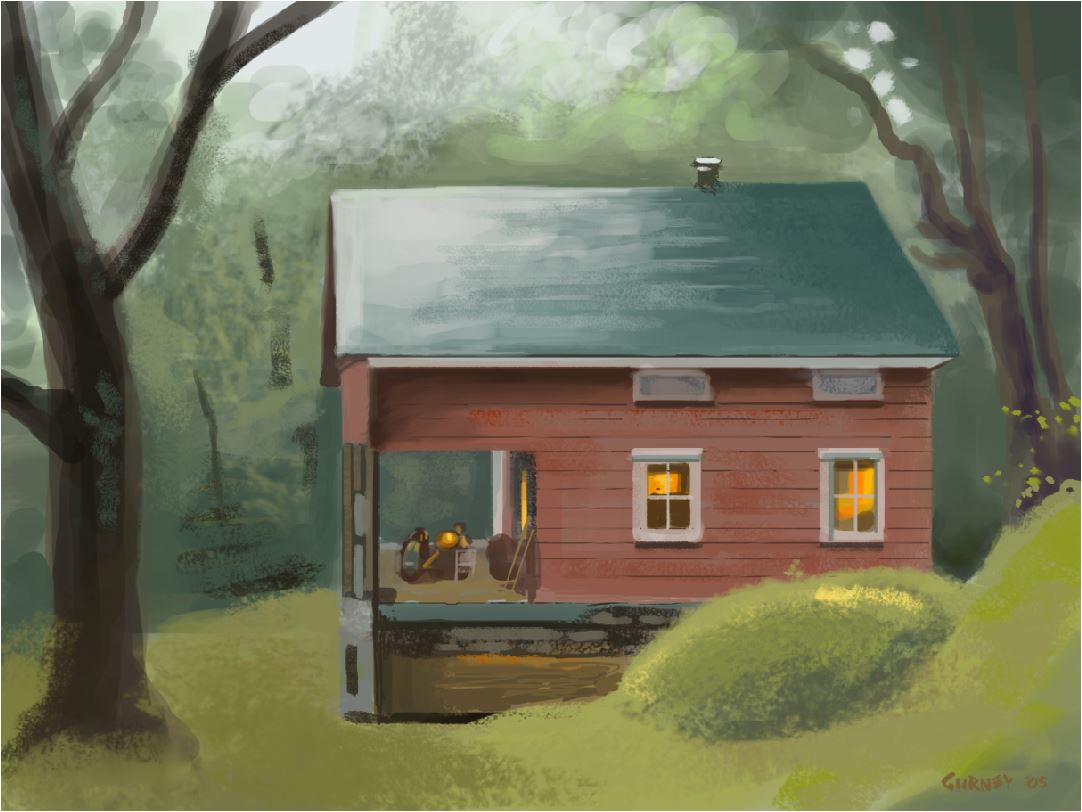02-25-2015, 04:05 AM
Hey guys,
I wanted to share some of the studies I did over the last weeks. They are all from James Gurney's book "Color and Light". You should buy it, if you don't already own it, it is pure gold and I always grab for it while painting something to remember myself of all those principles and things.
The first one is of Overcast Light
- this happens when the sky is full with clouds
- the light gets diffuses by the clouds and mostly colorless
- the light gets in most of the shadows so they are diffused too
- it is good for complex scenes, because you don't have to think a lot about shadow shapes
- also the color of the objects is mostly local-color
In "Light - for visual artists" by Richard Yot, it says three more important things:
- light on overcast days becomes bluer as the sun sets
- reflections on surfaces are coming from the whole sky so they too are softer than on sunny days
- the colors are quite saturated, because the are so little colors from the light mixing in

Window Light
- the natural light coming in from the window is usually cool, because it comes either from the sky (blueish) or from clouds (of course, if there is an artificial source, it can be every color)
- the underplanes are often hit by the surfaces outside (dirt, grass, concrete, etc.) so it is important to consider this
- the light from inside the room depends on the source but it is usually warm (lightbulb, fire), so it gives a nice contrast to the cool from the outside

Candlelight / Firelight
- it is warm
- it falls off really fast. James Gurney even quotes a calculation for the falloff, called the "inverse square law" http://en.wikipedia.org/wiki/Inverse-square_law.
- around the flame is often times smoke that gets illuminated and forms a halo

some watercolors of the same page. My scanner is not the best, so this will have to do right now.

this is from the book's cover

I will keep up the Gurney-studies, because they really help me to understand the content of the book better. Check back soon for more. :)
Cheers,
Flo
I wanted to share some of the studies I did over the last weeks. They are all from James Gurney's book "Color and Light". You should buy it, if you don't already own it, it is pure gold and I always grab for it while painting something to remember myself of all those principles and things.
The first one is of Overcast Light
- this happens when the sky is full with clouds
- the light gets diffuses by the clouds and mostly colorless
- the light gets in most of the shadows so they are diffused too
- it is good for complex scenes, because you don't have to think a lot about shadow shapes
- also the color of the objects is mostly local-color
In "Light - for visual artists" by Richard Yot, it says three more important things:
- light on overcast days becomes bluer as the sun sets
- reflections on surfaces are coming from the whole sky so they too are softer than on sunny days
- the colors are quite saturated, because the are so little colors from the light mixing in
Window Light
- the natural light coming in from the window is usually cool, because it comes either from the sky (blueish) or from clouds (of course, if there is an artificial source, it can be every color)
- the underplanes are often hit by the surfaces outside (dirt, grass, concrete, etc.) so it is important to consider this
- the light from inside the room depends on the source but it is usually warm (lightbulb, fire), so it gives a nice contrast to the cool from the outside
Candlelight / Firelight
- it is warm
- it falls off really fast. James Gurney even quotes a calculation for the falloff, called the "inverse square law" http://en.wikipedia.org/wiki/Inverse-square_law.
- around the flame is often times smoke that gets illuminated and forms a halo

some watercolors of the same page. My scanner is not the best, so this will have to do right now.
this is from the book's cover
I will keep up the Gurney-studies, because they really help me to understand the content of the book better. Check back soon for more. :)
Cheers,
Flo







